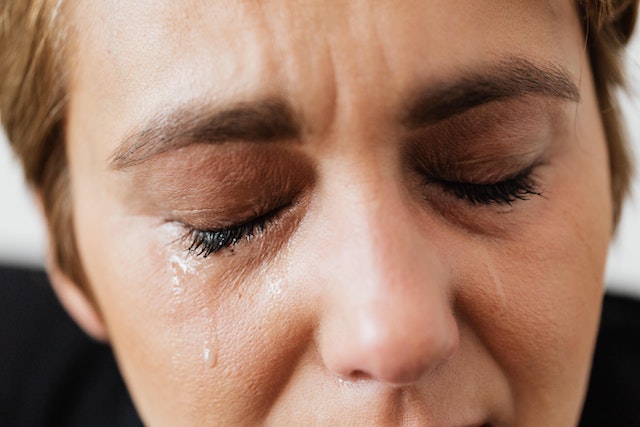
Do any other animals cry? Yes, but only to lubricate their eyes.
We have three types of tears. We have tears that lubricate and clean our eyes. These are called basal tears and they are created automatically. Every time you blink, the basal tears are spread across the eye and keep it wet and clear of dust. The second type of tears are called reflex tears. They are caused by irritation to the eye, such as the vapor from an onion. The third type of tears are emotional tears, caused by many different emotions.
(Incidentally – onions cause reflex tears because when they are cut they release enzymes and sulfenic acid, which combine to produce propanethial S-oxide. When the propanethial S-oxide comes into contact with the water on the eye, it becomes sulfuric acid. This is called a lachrymatory agent because it produces tears. The onion has evolved this ability as a defense against animals and insects. We have evolved the ability to cry to remove these irritants and protect our eyes.)
All three types of tears are produced in the nasolacrimal duct, which connects to the eye on one side and the nasal cavity on the other side. If you produce too many tears for your eyes, the excess will run down the nasal cavity. This is why your nose often runs when you cry. Tears contain water, salts, antibodies, and lysozymes. Lysozymes are antibacterial enzymes and their job is to protect the eye from infections.
Tears have different layers. The first layer is the mucus layer. This layer covers the eye’s surface and is hydrophilic, so it attracts the water and spreads it evenly over the ye. The middle layer is the water layer. It carries the salts, the antibodies, minerals, nutrients, and everything else the eye needs. The tears are the only source of nutrients for the cornea because it doesn’t have a blood supply. The last layer is the oil layer. The oil stops the eye from drying out and is hydrophobic so it keeps the tear together and stops it running out of the eye.
So, do animals cry? Pretty much all animals that have eyes have the ability to produce a fluid to lubricate them. However, there are no other animals that cry emotional tears. Most mammals are able to produce basal tears and reflex tears. Without them, their eyes can be damaged. Some animals can go long periods of time without blinking, and some animals use a third eyelid to lubricate their eyes, but almost all animals with eyes have to lubricate and protect them.
Some people often cite elephants and crocodiles as two animals that can cry real tears. They do appear to be crying, but they are not crying emotional tears. Elephants don’t have tear ducts. They can produce a fluid from other glands near their eye, but it has nowhere to drain to so it just runs out of their eyes and down their faces. This looks like crying, but it isn’t. They probably evolved this ability back when they were aquatic animals. Crocodiles produce tears when they are feeding. The fact that they appear to be crying as they kill their prey led to the expression “crocodile tears” which we use to mean someone who is pretending to cry. However, the same as with the elephant, these are not emotional tears. They are either producing tears to rid their body of excess salt that they have eaten with their prey. Or because when they feed it pushes warm air through their sinuses, stimulating their tear glands.
Why do we cry emotional tears, then? In truth, no one knows the reason, although there are several theories. One of the theories is that emotional crying is a social signal. We cry because we need the help of our group, or we want to show our group that we care. It is an evolved reaction that is something akin to a smile. Emotional tears contain more proteins than basal tears or reflexive tears. The reason for this is also not known, but it could be to make the tears stay on the face for longer. Other tears run away pretty quickly, but emotional tears are more viscous and hand on the face. This could be more proof that they are a social signal. Another idea is that crying is an automatic response that serves to balance hormone levels that are caused by stress. Crying can reduce stress, but experiments have shown that it doesn’t rid the body of any toxins. Yet another idea is that tears reduce aggression. Something in the makeup of emotional tears reduces aggression levels in men. Experiments are currently underway to see what that might be.
So, all animals cry, but humans are the only animals that cry emotional tears. And this is what I learned today.
Sources
https://www.healthline.com/health/why-do-onions-make-you-cry#why-onions-make-you-cry
https://en.wikipedia.org/wiki/Crocodile_tears
https://www.whyanimalsdothething.com/elephants-dont-cry
https://www.abc.net.au/radionational/programs/archived/bodysphere/features/4837824
https://www.abc.net.au/radionational/programs/archived/bodysphere/features/4837824
https://time.com/4254089/science-crying/
https://www.discovermagazine.com/health/humans-are-the-only-animals-that-cry-and-we-dont-know-why
